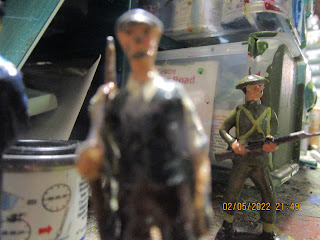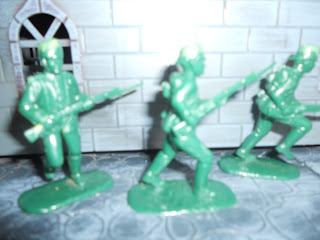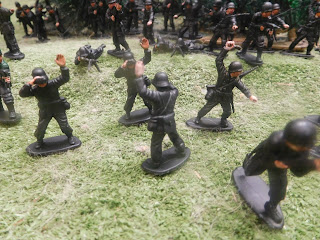A Britains Hollowcast Civilian Is Armed & Some Thoughts On Use Of Armed Civilians In Wargames
I obtained this Britains civilian from Darren at the ACOTS convention; He (the figurine, not Darren) was missing his right arm.
At one stage I intended to 'restore' such figures to their original appearance but how much more fun is it to make them a little bit different and better painted than the originals, whilst keeping something of the original charm?
So as a wargamer my instinct was to give him a weapon. I looked through my home cast spare rifle arms and selected a bolt action. I drilled a hole out in the arm and Super glued it over the lug and in place. Then I remembered that the other arm had a rolled sleeve so I filed the lower right arm down to match, something I should have done before gluing. I also used a thicker glue to fill in the hole where it came out on the outside.
He already looks better and I thought of the Irish rebels in the Easter Rising. It might have been because of the dark green vest. When I repaint I am going to use the same colors.
Below: Here he is, marching along as if he was a proper soldier and not just a civilian with a gun. He is in the company of the other hollowcast I have been repairing and a home cast sailor I painted.
After I sand down the top part of the arm where it is rough, I'll paint the figure and he will be ready to participate in any one of numerous late 19th, 20th and even 21st century conflicts. Let's see, Russian Revolution and Civil War, Spanish Civil War, Easter Rising, Mexican Revolution (they didn't all wear sombreros), Miners conflicts with bosses in America (on either side), Hungarian Revolution, French Resistance, imaginary invasions of Britain from late 19th century to mid 20th century as civil armed resistance.
There are other types of figures that can be used for partisans. I remember an old issue of Airfix magazine had an article about converting Airfix Afrika Corps into armed civilian resistance. You just cut off most or all the equipment and add putty (it was Plasticine then) to the bottom of the trousers to cover the gaiters and also to the cap to make what I call an Andy Capp cap. If you remember the cartoon strip you will know what I mean but it is the same style as the one the hollowcast civilian is wearing
Often these ununiformed civilians wore arm bands in national colors, political affiliation or just to distinguish form the enemy, which might also include armed civilians. That looks good but then limits the use of the figure although I suppose you could repaint the arm band each time a new scenario is used.
These sort of situations can get very messy when armed civilians remove their arm bands and melt back into the population because in many situations nasty reprisals can occur.
In fact the Geneva Convention does not extend so much of its protection to armed civilians. Traditionally they were treated like spies and did not get the stipulated POW treatment. (Of course some blighters do not observe the Geneva Convention with ANY enemy combatants any way).
I have played a few games with Mat where we diced to see the reaction of civilians when about to be visited by an invading army. This ranged from neutral, to fleeing and clogging up roads with refugees, to helping the interlopers, to blockading streets and manning barricades to resist them. In the last case the object was to hold out until their nation's or faction's army could arrive. Often a civilian would stay hidden in a building and emerge to throw a Molotov Cocktail or grenade.
Generally it is expected that discipline, leadership and marksmanship would be lower than with normal military combatants but this might not always be the case. I allow for there to be some veterans and natural leaders, even the odd political officer, policeman or big game hunter who stiffen the resistance. This could be decided before hand or diced for during the game. it is fun to add characters as heroes and leaders They have better leadership and better ballistic skill or/and melee ability as, possibly more than one wound and attack.
.














Excellent posting. The French Resistance, the Russian Partisans, and German Volkssturm all wore mostly civilian dress. The Germans wore an armband under the legal interpretation that it was their "uniform" and so entitled them to protections from the Geneva Convention.
ReplyDelete